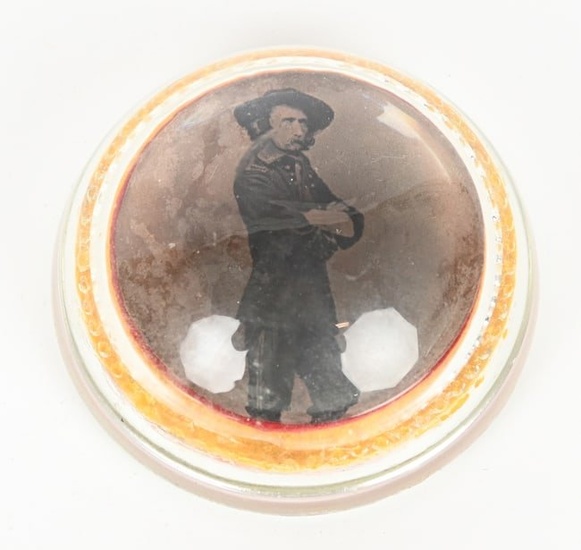GENERAL GEORGE ARMSTRONG CUSTER EARLY PAPERWEIGHT
Early George Armstrong Custer Paperweight measuring 3 inches wide with a bubble top and a yellow and red felt insert with an image of the infamous Union General. Excellent. George Armstrong Custer (December 5, 1839 – June 25, 1876) was a United States Army officer and cavalry commander in the American Civil War and the American Indian Wars. Custer graduated from West Point in 1861 at the bottom of his class, but since the Civil War was just starting, trained officers were in immediate demand. He worked closely with General George B. McClellan and the future General Alfred Pleasonton, both of whom recognized his ability as a cavalry leader. He was subsequently promoted to brigadier general of volunteers at age 23. Only a few days after his promotion, he fought at the Battle of Gettysburg, where he commanded the Michigan Cavalry Brigade. Despite being outnumbered, Custer defeated J. E. B. Stuart's attack at what is now known as East Cavalry Field. In 1864, he served in the Overland Campaign and Philip Sheridan's army in the Shenandoah Valley, defeating Jubal Early at Cedar Creek. In 1865, he destroyed or captured the remainder of Early's forces at the Battle of Waynesboro. His division blocked the Army of Northern Virginia's final retreat and received the first flag of truce from the Confederates. He was also present at Robert E. Lee's surrender to Ulysses S. Grant at Appomattox Court House, Virginia. After the war, Custer was commissioned as a lieutenant colonel in the Regular Army and was sent west to fight in the Indian Wars, mainly against the Lakota and other Plains Peoples. On June 25, 1876, while leading the 7th Cavalry Regiment at the Battle of the Little Bighorn in Montana Territory against a coalition of Native American tribes, he was killed along with every soldier of the five companies he led. This event became known as "Custer's Last Stand". His dramatic end was as controversial as the rest of his career, and the reaction to his life and career remains deeply divided. His legend was partly his own fabrication through his extensive publicity, and perhaps more through the energetic lobbying of his wife Elizabeth Bacon "Libbie" Custer throughout her long widowhood which spanned six decades.
[ translate ]Bid on this lot
Estimate
Reserve
Time, Location
Auction House
Early George Armstrong Custer Paperweight measuring 3 inches wide with a bubble top and a yellow and red felt insert with an image of the infamous Union General. Excellent. George Armstrong Custer (December 5, 1839 – June 25, 1876) was a United States Army officer and cavalry commander in the American Civil War and the American Indian Wars. Custer graduated from West Point in 1861 at the bottom of his class, but since the Civil War was just starting, trained officers were in immediate demand. He worked closely with General George B. McClellan and the future General Alfred Pleasonton, both of whom recognized his ability as a cavalry leader. He was subsequently promoted to brigadier general of volunteers at age 23. Only a few days after his promotion, he fought at the Battle of Gettysburg, where he commanded the Michigan Cavalry Brigade. Despite being outnumbered, Custer defeated J. E. B. Stuart's attack at what is now known as East Cavalry Field. In 1864, he served in the Overland Campaign and Philip Sheridan's army in the Shenandoah Valley, defeating Jubal Early at Cedar Creek. In 1865, he destroyed or captured the remainder of Early's forces at the Battle of Waynesboro. His division blocked the Army of Northern Virginia's final retreat and received the first flag of truce from the Confederates. He was also present at Robert E. Lee's surrender to Ulysses S. Grant at Appomattox Court House, Virginia. After the war, Custer was commissioned as a lieutenant colonel in the Regular Army and was sent west to fight in the Indian Wars, mainly against the Lakota and other Plains Peoples. On June 25, 1876, while leading the 7th Cavalry Regiment at the Battle of the Little Bighorn in Montana Territory against a coalition of Native American tribes, he was killed along with every soldier of the five companies he led. This event became known as "Custer's Last Stand". His dramatic end was as controversial as the rest of his career, and the reaction to his life and career remains deeply divided. His legend was partly his own fabrication through his extensive publicity, and perhaps more through the energetic lobbying of his wife Elizabeth Bacon "Libbie" Custer throughout her long widowhood which spanned six decades.
[ translate ]


